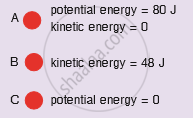Advertisements
Advertisements
प्रश्न
A girl with having a mass of 35 kg sits on a trolley of mass 5 kg. The trolley is given an initial velocity of 4 m s–1 by applying a force. The trolley comes to rest after traversing a distance of 16 m. (a) How much work is done on the trolley? (b) How much work is done by the girl?
उत्तर
Effective mass of girl + trolley system = mass of girl + mass of trolley = 35 kg + 5 kg = 40 kg
Here, u = 4 10m s−1, v – 0, s = 16 m
Using v2 – u2= 2as, we get
a = `("v"^2 - "u"^2)/(2"s")`
= `(0 - 4^2)/(2 xx 16)`
= `(-1)/2 "m s"^-2`
∴ Force, F = ma = `40 xx ((-1)/2)"N"`
= −20N
(a) Work done on the trolley = – Work done by the trolley
= − Fs
= – (–20 N) × (16 m)
= 320 J
(b) As the girl keeps sitting on the trolley, there is no displacement in her position with respect to the trolley, so no work is done by the girl.
APPEARS IN
संबंधित प्रश्न
State the condition under which the mechanical energy is conserved.
What kind of energy is possessed by the following?
A compressed spring ____________.
What kind of energy is possessed by the following?
A stretched rubber band _____________
Fill in the blanks with suitable words:
When a ball is thrown upwards, ___________ energy is transformed into ___________ energy.
The hanging bob of a simple pendulum is displaced to one extreme position B and then released. It swings towards centre position A and then to the other extreme position C. In which position does the bob have :
(i) maximum potential energy?
(ii) maximum kinetic energy?
Name the energy transfers which occur when : there is a picture on a television screen
A ball falls to the ground as shown below :
Which law you have made use of in answering this question?
In the case of negative work, the angle between the force and displacement is
A girl is carrying a school bag of 3 kg mass on her back and moves 200 m on a levelled road. The work done against the gravitational force will be (g = 10 m s–2)
An automobile engine propels a 1000 kg car (A) along a levelled road at a speed of 36 km h–1. Find the power if the opposing frictional force is 100 N. Now, suppose after travelling a distance of 200 m, this car collides with another stationary car (B) of the same mass and comes to rest. Let its engine also stop at the same time. Now the car (B) starts moving on the same level road without getting its engine started. Find the speed of the car (B) just after the collision.
